
The 2007 San Diego Chargers season began with the team trying to equal their 2006 regular season success (14–2) and avoid another early departure in the playoffs. After a disappointing start under new head coach Norv Turner (1–3), they finished the regular season strong, with six straight wins, an overall record of 11–5, and the AFC West title. More importantly, they went further in the playoffs than the previous year, but fell again to the New England Patriots, this time in the AFC Championship game.
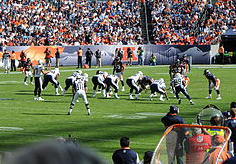
2008 San Diego Chargers playing against the Denver Broncos.
After beating the Tampa Bay Buccaneers on Sunday December 21, 2008, the Chargers stood at 7–8, one game behind the Denver Broncos. Denver's loss to the Buffalo Bills later that same day created a primetime showdown between Denver and San Diego in San Diego for the AFC West Championship, as well as the fourth seed in the playoffs. The Chargers won the 2008 AFC West championship in convincing fashion by beating Denver in a 52–21 blowout. On January 3, 2009, the San Diego Chargers defeated the Indianapolis Colts 23–17 in overtime to advance to the AFC Divisional Playoff round. On January 11, 2009 the Chargers were defeated by the Pittsburgh Steelers 35–24 in the AFC Divisional Game ending the 2008 San Diego Chargers season.
2009
Main article: 2009 San Diego Chargers season
The Chargers started the 2009 campaign slowly, with a 2–3 record, a trend under current coach Norv Turner (1–3 in 2007 & 2–3 in 2008).[58] By that time, theBroncos were 6–0, and had a 31⁄2 game lead over the Chargers. Most pundits said the AFC West was already decided and the Chargers would have to play for the wildcard. Most fans wanted the coach to be fired, especially after a lackluster performance at Oakland & Pittsburgh. But then, like all of their seasons under Turner, they played their best football at the end of the regular season. This was a season of the continual improvement of Philip Rivers & the passing game, and LaDainian Tomlinson no longer being the focus of the offense. Rivers threw for 4,254 yards (8th), 28 TD's (tied-6th), 8.8 yards per passing attempt (1st), 64 completions of 20+ yards (1st), only 9 INT's (4th with a minimum 400 pass attempts), and a 104.4 passer rating (3rd – only beaten by Drew Brees& Brett Favre).[59] They would go on to win the AFC West, (their 4th straight division title, only Oakland with five straight 1972–1976 is better), along the way blowing out the Denver Broncos with a convincing 32–3 victory at Denver and defeating every NFC East team. They finished the regular season with 11 straight wins (tying the 1961 team record & is also tied for the 5th longest win streak entering the playoffs), finished with an impressive 13–3 record, (including 4–0 in December, extending their NFL record with 18 straight wins in December, & also tying theDolphins 1970–1974 in November for the longest winning streak in any month). They locked up the second seed as well as a first round bye but this served them no advantage in the playoffs as they lost at home to the Jets 17–14 (the only home team with a bye to lose in the divisional round). This was due to an overly conservative offense settling for FG's & the kicker, Nate Kaeding, missing all 3 attempts.[60]
2010–2012: Injuries, inconsistencies, and the end of the Norv Turner/AJ Smith era.
2010
Main article: 2010 San Diego Chargers season
2010 was the 1st season without LaDainian Tomlinson since 2000 (let go by management due to an over-sized contract relative to production and other issues, he went on to lead the Jets in rushing with 914 yards & tied for 3rd in receptions with 52). The 2010 campaign started off slowly again, this time 2–5 (including losses to some of the worst teams in football at the time – KC, OAK, SEA & STL). The losses were due to turnovers & mental mistakes by young players on special teams allowing blocked punts & kick/punt return TD's. The loss to Oakland ended their 13 game winning streak against the Raiders since their last loss on September 28, 2003.[61] The Chargers then went on another second half run with four straight wins but this time instead of keeping the streak going the entire second half they had a big let down losing at home to the Raiders again, this time 28–13 (ending their shared NFL record, with the Dolphins, of 18 straight wins in December).[62] Despite the loss, they still had a chance to win their 5th straight AFC West title, tying the Raiders, but they had another bad loss at the Bengals 34–20 ending their chances. The Chargers beat Denver to end the season with a 9–7 record & out of the playoffs for the first time since 2005. They finished the season as the 8th team in NFL history to rank #1 in overall offense (395.6 yards/game), and overall defense (271.6 yards/game), and became only the 2nd of those teams to not make the playoffs (1953 Eagles 7–4–1).[63] They were second to the Colts in passing yards per game (282.4), second to the Patriots in points scored per game (27.6), 1st in passing yards allowed per game (177.8), 4th in rushing yards allowed per game (93.8), and tied for 2nd in sacks (47). On the negative stat sheet, they gave up the most punt return yards per game (18.9) & had 29 turnovers.[64] Philip Rivers had another great season with a career-high 4,710 yards (#1 in the NFL), 294 yards passing per game (tied for 1st with Manning), 66% completion pct. (third to Brees& Manning), 30 TD's, only 13 INT's & a 101.8 passer rating (second to Brady). Mike Tolbert 11 rushing TD's & Antonio Gates 10 receiving TD's were among the league leaders in TD's scored. On defense, Shaun Phillips' 11 sacks were in the top 10.[65]
With the special teams failure of the 2010 season campaign, the Chargers hoped to rebound with a strong performance to start the season, and a way to overcome slow starts.
2011
Main article: 2011 San Diego Chargers season
The Chargers started off the 2011 season with a 4-1 campaign, with their only loss to the New England Patriots. From that point on, however, the Chargers began a six game skid with losses to the Jets, Chiefs, Packers, Raiders, Bears and Broncos with the first four by only a score and against Denver in overtime. Injuries to both the offensive and the defensive line have hit the Chargers hard. But finally on December 5, 2011, the Chargers got their first win in over a month against the Jacksonville Jaguars, beating their also-struggling team. The Chargers then began a three game winning streak most notably beating the Ravens by more than any team has beat them this season. However, the Chargers were beaten, 38-10, by the Detroit Lions to drop their record to 7-8 and eliminate the possibility of being in the playoffs. After a 38-26 victory over the Raiders in week 17, the Chargers finished at 8-8 and in a numerical tie for first place in the AFC West along with Oakland and Denver. However, the Chargers were beaten out by Denver for the Division Title via tie-breaker.
2012
Main article: 2012 San Diego Chargers season
On October 21, 2012, a line judge saw what he thought was a suspicious substance on hand towels used by the players. If the NFL determined the Chargers were using banned adhesives during game time, they would've suffered the consequences, such as a fine or loss of an important draft pick for next season.[66] However, on November 7, the league announced that the Chargers did not cheat, though the team was fined $20,000.[67] After missing the playoffs for the third straight season in 2012, the Chargers fired general manager Smith and head coach Turner.[68]
2013
On January 9, 2013, the Chargers announced that Tom Telesco, former Vice President of Football Operations with the Indianapolis Colts, would take over as General Manager following the firing of A.J. Smith. On January 15, Denver offensive coordinator Mike McCoy was hired as the new head coach and Ken Whisenhunt as Offensive coordinator. The San Diego Chargers selected D. J. Fluker, Manti Te'o and Keenan Allen in the first three rounds of the 2013 N.F.L Draft.[69]
Logo and uniforms
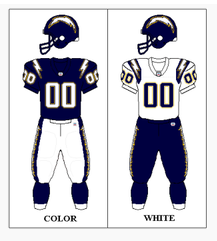
San Diego Chargers uniform: 1992–2006. During most seasons, the Chargers' road uniforms included white socks with navy blue stripes.
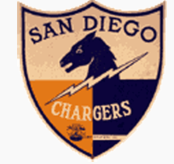
Chargers' AFL logo 1966–1969
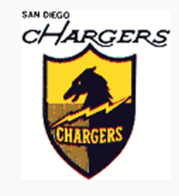
Chargers AFL logo
Except for color changes, the Chargers have basically used the logo of an arc-shaped lightning bolt since the team debuted in 1960. During its period in the AFL, the club also used a shield logo that featured a horsehead, a lightning bolt, and the word "Chargers".
From 1960 to 1973, the colors consisted of various shades of Electric blue ("powder" blue, but technically called Collegiate blue) or white jerseys, both with gold lightning bolts on the shoulders. The helmets were white and had both the arc-shaped lightning bolt logo, in gold or navy depending on the year, and the player's number. At first, the team wore white pants before switching to gold in 1966.
In 1974, the sky blue was changed to dark royal blue. The helmet was also changed to dark blue and the players' numbers were removed. From 1978 through 1983, the Chargers wore their white jerseys at home, coinciding with the hiring of coach Don Coryell – when Joe Gibbs, a Coryell assistant in 1979–80, became head coach of the Washington Redskins in 1981, he did the same, and white at home became a Redskins staple through 2007 – but Coryell switched the Chargers to their blue jerseys at home starting in 1984. With the exception of the 1991 season and other sporadic home games since, San Diego wears its blue jerseys at home.
In 1985, the Chargers started using navy blue jerseys and returned to wearing white pants. The team's uniform design was next revamped in 1988. It featured an even darker shade of navy blue. The lightning bolts on the jerseys and helmets were white, with navy interior trim and gold outlining. In 1990, the team started to wear navy pants with their white jerseys. From 1988 to 1991, the team displayed stripes down the pants rather than lightning bolts. The Chargers went with all-white combinations in 1997 and 2001, only to have the blue pants make a comeback. On October 27, 2003, the Chargers wore their navy pants with their navy jersey for a Monday Night Football game versus the Miami Dolphins that was played at Sun Devil Stadium, then the home of the Arizona Cardinals, due to wildfires in southern California. This remains the only game in which the Chargers have worn the all-dark combination.
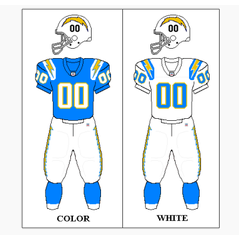
Throwback uniforms worn in 1994 (NFL 75th anniversary) and 2009 (AFL 50th anniversary); powder blue throwback was also used in 2000 for Chargers' 40th anniversary and as an alternate uniform from 2002 to 2006.
.
From the late 1980s to 2000, the Chargers wore white at home during some preseason games and dark for regular season games. In 2001, the Chargers started wearing their dark uniforms for preseason games and white uniforms in September home games due to the heat before switching back to dark in October.
In March 2007, the Chargers unveiled their first uniform redesign since 1988, on the team's official website. The team formally unveiled this new uniform set, which mixes old and new styles, in a private team-only event. Navy blue remains the primary color on the home jersey, but the familiar lightning bolt was reverted to gold, and now has navy outlining and Collegiate (powder) blue interior trim. The latter color is a nod to the 1960s uniforms. The redesigned lightning bolt was moved to the sides of the shoulders from the top, and includes a new numbering font and word mark in white, with gold outlining and powder blue interior trim. The pants also have a redesigned lightning bolt in gold, with powder blue trim on a navy stripe. Additionally, the team pays tribute to other uniform features from their history by wearing a metallic white helmet, with a navy face mask, the newly revamped bolt in gold with navy and powder blue trim, and white pants. The road white jerseys with navy pants, as well as the alternate powder blue jerseys with white pants, were also redesigned with the new scheme.
From 2002 to 2006, the Chargers used the early-1960s powder blue uniforms as alternate jerseys, which many football fans (both of the Chargers and of other teams) clamored for the team to bring back full-time.
Since 2007, the Chargers have worn the alternate powder blue jerseys twice per season, most recently in a November 25, 2012 game vs. the Baltimore Ravens.[70] The alternate powder blue jerseys were also worn for a game against the Indianapolis Colts in the 2008 playoffs.
In 2009, in honor of their 50th anniversary as one of the eight original AFL teams, the Chargers wore their 1963 throwback uniforms for three games.
The Chargers wear their white jerseys for home games early in the regular season due to higher summer temperatures.
Retired numbers
Main article: San Diego Chargers retired numbers
The Chargers currently have three retired numbers: #14 (Dan Fouts), #19 (Lance Alworth) and #55 (Junior Seau). As of 2010, the Chargers' policy was to have the Chargers Hall of Fame committee evaluate candidates for a player's number to retire after the player has retired from the league after five years,Seau was the only exception to this policy. The committee consists of Chargers Executive Vice President Alex Spanos, Chargers public relations director Bill Johnston,San Diego Hall of Champions founder Bob Breitbard, and the presidents of the San Diego Sports Commission and the Chargers Backers Fan Club. There are few recognized guidelines in sports regarding retiring numbers, and the NFL has no specific league policy. "You have to have enough numbers for players to wear," said NFL spokesman Greg Aiello.[71] The Chargers have rarely retired numbers.[72] The San Diego Union-Tribune wrote, "The [Chargers] tend to honor their heritage haphazardly."[73]
Pro Football Hall of Famers
| San Diego Chargers Hall of Famers | |||
|---|---|---|---|
| No. | Player | Position | Tenure |
| 19 | Lance Alworth | WR | 1962–1970 |
| 71 | Fred Dean | DE | 1975-81 |
| 14 | Dan Fouts | QB | 1973–1987 |
| - | Sid Gillman | Head coach | 1960-71 |
| 18 | Charlie Joiner | WR | 1976-86 |
| 75 | Deacon Jones | DE | 1972-73 |
| 89 | John Mackey | TE | 1972 |
| 74 | Ron Mix | OT | 1960-69 |
| 19 | Johnny Unitas | QB | 1973 |
| 80 | Kellen Winslow | TE | 1979-87 |
Chargers Hall of Fame
Main article: List of San Diego Chargers Hall of Fame inductees
The Chargers created their Hall of Fame in 1976.[74] The members of the Hall of Fame are honored at the Chargers Ring of Honor, founded in 2000 and viewable above the visiting team's sideline of Qualcomm Stadium on the press level.[75][76]Eligible candidates must have been retired for at least four seasons.[77] The Chargers in 2012 began allowing fans to vote for the newest member.[78] Previously, selections were made by a five-member committee chaired by Dean Spanos, Chargers vice-chairman. As of 1992, other committee members included Bob Breitbard, founder of the San Diego Hall of Champions; Ron Fowler, president of the Greater San Diego Sports Association; Jane Rappoport, president of the Charger Backers; and Bill Johnston, the team's director of public relations.[77]
50th Anniversary Team
Main article: List of San Diego Chargers 50th Anniversary Team
See also: List of San Diego Chargers 40th Anniversary Team
The Chargers announced their 50th Anniversary Team in 2009 to honor the top players and coaches in the team's history. The Chargers were founded in 1959.[79] The team included 53 players and coaches selected from 103 nominees.[80][81][82] The Chargers originally stated that only 50 members would be selected.[82] Online voting by fans accounted for 50 percent of the voting results; votes from Chargers Hall of Famers and five members of the local media made up for the other 50 percent. Over 400,000 votes were cast online. Dan Fouts and LaDainian Tomlinson received the first and second most votes, respectively.[81][83] The team features seven Pro Football Hall of Fame members and 11 players that were active on the 2009 Chargers team.[84][85]
San Diego Hall of Champions
Alworth, Mix, Hadl, Joiner, Coryell, Gillman, Garrison, Fouts, White, Winslow, Faison, Benirschke, Lincoln, Washington, Humphries, Ladd and Wilkerson are also members of the San Diego Hall of Champions, which is open to athletes from the San Diego area as well as those who played for San Diego-based professional and collegiate teams.
Radio and television
The Chargers' flagship station is KIOZ 105.3FM, commonly known as "Rock 1053." Josh Lewin and Hank Bauer comprise the broadcast team. Past Chargers radio broadcasters have included Ralph Lawler, Stu Nahan, Tom Kelly, Lee "Hacksaw" Hamilton, Dan Rowe and Ted Leitner. Most preseason games are televised on KFMB in San Diego and KCBS in Los Angeles. The announcers were Ron Pitts and Billy Ray Smith.
Since the Los Angeles market is within the Chargers' 75-mile radius (which prohibits national radio broadcasts of Charger games from being carried on a Los Angeles station during the regular season), the Chargers Radio Network has a secondary flagship station for Los Angeles: KLAC AM-570, in Los Angeles and Orange County. The previous Los Angeles flagship was KSPN AM-710 and before that, KMPC AM-1540 for several years.
Dennis Packer, the public address announcer of all USC football games at the Los Angeles Memorial Coliseum, serves as the P.A. announcer of all Charger home games at Qualcomm Stadium. Packer replaced legendary P.A. announcer Bruce Binkowski, who went on to become the executive director of the Holiday and Poinsettia Bowl games.
Radio Affiliates
Chargers Radio Network
English
| City | Call Sign | Frenquency |
| San Diego, California | KIOZ-FM | 105.3 FM |
| San Diego, California | KLSD-AM | 1360 AM |
| Temecula, California | KATY-FM | 101.3 FM |
| Riverside, California | KCAL-FM | 96.7 FM |
| Los Angeles, California | KLAC-AM | 570 AM |
| Bakersfield, California | KGEO-AM | 1230 AM |
| Reno, Nevada | KHIT-AM | 1450 AM |
| Yucca Valley, California | KNWH-AM | 1250 AM |
| Palm Springs, California | KNWQ-AM | 1140 AM |
| Coachella, California | KNWZ-AM | 970 AM |
| Coachella, California | KNWZ-FM | 94.3 FM |
| Lancaster, California | KOSS-AM | 1380 AM |
| Ontario, California | KSPA-AM | 1510 AM |
| Honolulu, Hawaii | KUPA-AM | 1370 AM |
| Victorville, California | KVFG-FM | 103.1 FM |
| Ridgecrest, California | KWDJ-AM | 1360 AM |
| Las Vegas, Nevada | KWWN-AM | 1100 AM |
| El Centro, California | KXO-FM | 107.5 FM |
Spanish
| City | Call Sign | Frenquency |
| Tijuana, Mexico | XHFG-FM | 107.3 FM |
| Los Angeles, California | KWKW-AM | 1330 AM |
| Mexicali, Mexico | XHSOL-FM | 89.9 FM |
| Ensenada, Mexico | XEHC-AM | 1590 AM |
Theme song
Main article: San Diego Super Chargers
The Chargers' fight song, "San Diego Super Chargers", was recorded in 1979 at the height of the team's success with Air Coryell, and has a distinctly disco sound. The team under then-new owner Alex Spanos replaced the song in 1989 with a non-disco cover version, but the original version was revived in 2002. The team plays this song at home games after Chargers scores and victories. From time to time during highlights of NFL PrimeTime, ESPN's Chris Berman and Tom Jacksonwould briefly sing the first line of the song's chorus.



















